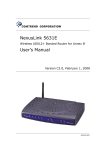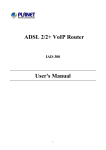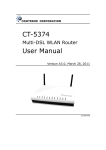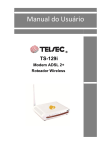Download KW5262 Wireless VDSL Router User Manual
Transcript
KW5262 Wireless VDSL Router User Manual VDSL Router User Manual NOTICE This document contains proprietary information protected by copyright, and this Manual and all the accompanying hardware, software, and documentation are copyrighted. All rights are reserved. No part of this document may be photocopied or reproduced by mechanical, electronic, or other means in any form. The manufacturer does not warrant that the hardware will work properly in all environments and applications, and makes no warranty or representation, either expressed or implied, with respect to the quality, performance, merchantability, or fitness for a particular purpose of the software or documentation. The manufacturer reserves the right to make changes to the hardware, software, and documentation without obligation to notify any person or organization of the revision or change. All brand and product names are the trademarks of their respective owners. © Copyright 2014 All rights reserved. VDSL Router User Manual Content 1.1 FEATURES....................................................................................................................... 2 1.1.1 Data rate ............................................................................................................................ 2 1.1.2 DSL Compliant ................................................................................................................. 2 1.1.3 Wireless ............................................................................................................................. 2 1.1.4 Network Protocol & Features ......................................................................................... 2 1.1.5 ATM Capabilities .............................................................................................................. 3 1.1.6 VoIP .................................................................................................................................... 3 1.1.7 FIREWALL ........................................................................................................................ 4 1.1.8 Management Support ...................................................................................................... 4 1.1.9 Operating System Support ............................................................................................. 4 1.1.10 Environmental ................................................................................................................... 4 1.2 PACKET CONTENTS ....................................................................................................... 4 1.3 SYSTEM REQUIREMENTS ................................................................................................ 5 1.4 FACTORY DEFAULTS ...................................................................................................... 5 1.5 WARNINGS AND CAUTIONS ............................................................................................. 5 2 HARDWARE DESCRIPTION ...................................................................................................... 7 3 HARDWARE INSTALLATION .................................................................................................... 9 4 PC CONFIGURATION GUIDE .................................................................................................. 10 4.1 LOCAL PC CONFIGURATION IN WINDOWS 95, 98, ME, XP,VISTA,7 .............................. 10 4.2 LOCAL PC CONFIGURATION IN WINDOWS 2000 ............................................................. 10 5 WEB-BASED MANAGEMENT GUIDE .................................................................................... 11 5.1 LAN SETTING PAGE ....................................................................................................... 11 5.2 INTERNET ACCESS CONFIGURATION ............................................................................... 12 5.2.1 ADSL Setup ....................................................................................................................... 12 5.2.2 VDSL Setup ....................................................................................................................... 17 5.2.3 Router Mode Setup ........................................................................................................... 22 5.2.4 LAN Settings ...................................................................................................................... 27 5.3 WIRELESS SETTING ....................................................................................................... 29 5.3.1 Basic ................................................................................................................................... 29 5.3.2 Advanced ....................................................................................................................... 30 5.3.3 Security ............................................................................................................................ 33 5.4 VOIP CONFIGURATION ................................................................................................... 37 5.4.1 SIP Basic Setting .............................................................................................................. 37 5.4.2 SIP Advanced Setting....................................................................................................... 38 5.5 PRINTER SERVER INSTALLATIONS ................................................................................. 39 APPENDIX: FREQUENT ASKED QUESTIONS ..................................................................... 42 1 VDSL Router User Manual 1 Overview Thank you for choosing our product. The KW5262 is a Wireless VDSL router combining an DSL modem, an 802.11n wireless router, a 4-port switch, two FXS ports and an USB port in one unit, bringing high-speed wireless Internet connection to a home or office. 1.1 Features 1.1.1 Data rate Downstream data rate up to 100 Mbps Upstream data rate up to 50Mbps(100 Mbps upstream with external AFE) 1.1.2 DSL Compliant ITU G.992.1 (G.DMT) ITU G.993.2 (G.vdsl2) (Profile 8a, 8b, 8c, 8d, 12a,12b and 17a; 30a optional) ITU G.992.2 (G.Lite) ITU G.994.1 (G.hs) ITU G.992.3 (G.DMT.BIS) ITU G.992.4 (G.lite.bis) ITU G.992.5 Compatible with all T1.413 issue 2 (full rate DMT over analog POTS), and CO DSLAM equipment 1.1.3 Wireless Fully IEEE 802.11n compatible. Wireless data rate up to 300Mbps Operating in the unlicensed 2.4 GHz ISM band Multi-SSID Supports 64/128 bits WEP security and user authentication 1.1.4 Network Protocol & Features Ethernet to ADSL Self-Learning Transparent Bridging 2 VDSL Router User Manual Internet Control Message Protocol (ICMP) IP Static Routing Routing Information Protocol (RIP, RIPv2) Network Address Translation (NAT) Virtual Server, Port Forwarding Dynamic Host Configuration Protocol (DHCP) DNS Relay, DDNS IGMP Proxy Simple Network Time Protocol (SNTP) VPN pass-through (IPSec/PPTP/L2TP) Parent control 1.1.5 ATM Capabilities RFC 1483 Multi-protocol over ATM “Bridged Ethernet” compliant RFC 2364 PPP over ATM compliant RFC 2516 PPP over Ethernet compliant ATM Forum UNI3.1/4.0 PVC - Up to 16 PVCs VPI Range: 0-255 VCI Range: 32-65535 UNI 3.0 & 3.1 Signaling ATM AAL5 (Adaption Layer type 5) OAM F4/F5 1.1.6 VoIP SIP Voice codecs: G.711A/µ, G.723, G.726, G.729 Call waiting Call forwarding 3 VDSL Router 1.1.7 1.1.8 1.1.9 1.1.10 1.2 User Manual FIREWALL Built-in NAT MAC Filtering Packet Filtering Stateful Packet Inspection (SPI) Denial of Service Prevention (DoS) DMZ Management Support Web Based GUI Upgrade or update via FTP/HTTP Command Line Interface via Telnet Diagnostic Test Firmware upgrade-able for future feature enhancement Operating System Support WINDOWS 98/98 SE WINDOWS ME WINDOWS 2000 WINDOWS XP WINDOWS VISTA WINDOWS 7 Macintosh LINUX Environmental Operating humidity: 10%-90% non-condensing Non-operating storage humidity: 5%-95% non-condensing Packet Contents The packet contents are as the following: 4 VDSL Router 1.3 User Manual DSL ROUTER x1 External Splitter x1 Power Adapter x1 Telephone Line x1 Ethernet Cable x1 Antenna x2 Base x1 CD x1 System Requirements Before using this ROUTER, verify that you meet the following requirements: Subscription for DSL service. Your DSL service provider should provide you with at least one valid IP address (static assignment or dynamic assignment via dial-up connection). One or more computers, each contains an Ethernet 10/100M Base-T network interface card (NIC). A hub or switch, if you are connecting the device to more than one computer. For system configuration using the supplied web-based program: A web browser such as Internet Explorer v5.0 or later, or Netscape v4.7 or later. 1.4 Factory Defaults The device is configured with the following factory defaults: IP Address: 192.168.31.1 Subnet Mask: 255.255.255.0 User Name: admin Password: admin VPI/VCI: According to local information 1.5 Warnings and Cautions Never install telephone wiring during storm. Avoid using a telephone during an electrical storm. There might be a risk of electric shock from lightening. 5 VDSL Router User Manual Do not install telephone jacks in wet locations and never use the product near water. To prevent dangerous overloading of the power circuit, be careful about the designed maximum power load ratings. Not to follow the rating guideline could result in a dangerous situation. Please note that telephone line on modem must adopt the primary line that directly outputs from junction box. Do not connect Router to extension phone. In addition, if your house developer divides a telephone line to multi sockets inside the wall of house, please only use the telephone that has connected with the splitter of DSL Router when you access the Internet. Under the above condition, if you also install telephone with anti-cheat-dial device, please pull out this kind of telephone, otherwise DSL Router may occur frequently off-line. 6 VDSL Router User Manual 2 Hardware Description Front Panel LED Color PWR Green Function On: Power on Off: No power On: LAN link established and active via LAN port LAN1,2,3,4 Green Blinking: DSL data activity occurs Off: No LAN link via LAN port On: The wireless module is ready and idle WLAN Green Blinking: Data transmitting or receiving over WLAN Off: The wireless is not installed. On: DSL link established and active DSL Green Quick blinking: DSL is trying to establish a connection Slow blinking: No DSL link On: IP connected. INET Blinking: IP connected and IP traffic is passing through Green the device. Off: DSL connnection not present. On:A telephone connected to the phone port has its receiver off of the hook . VOIP1,2 Green Off: The handset of telephone connected to the phone port is on-hook. 7 VDSL Router User Manual Rear panel Port Function DSL Connect the device to an ADSL telephone jack or splitter using a RJ-11 telephone cable FXS0,1 Connect the device to your normal phone Connect the device to your printer LAN1,2,3,4 Connect the device to your PC's Ethernet port, or to the uplink port on your hub/switch, using a RJ-45 cable ON/OFF POWER Switch it on or off Connect to the supplied power adapter Side Panel WIFI: The switch of wireless function RESET: System reset or reset to factory defaults WPS: A convenient way to set wireless security 8 VDSL Router User Manual 3 Hardware Installation This chapter shows you how to connect Router. Meanwhile, it introduces the appropriate environment for the Router and installation instructions. 1. Using a telephone line to connect the DSL port of ROUTER to the MODEM port of the splitter, and using a other telephone line connect your telephone to the PHONE port of the splitter, then connect the wall phone jack to the LINE port of the splitter. The splitter comes with three connectors as below: LINE: Connects to a wall phone jack (RJ-11 jack) MODEM: Connects to the DSL jack of ROUTER PHONE: Connects to a telephone set 2. Using an Ethernet Cable to connect the LAN port of the ROUTER to your LAN or a PC with network card installed. 3. Connect the power cable to the PWR connector on ROUTER, then plug in the power adapter to the power outlet, and then press the on-off button. Notes: Without the splitter and certain situation, transient noise from telephone can interfere with the operation of the Router, and the Router may introduce noise to the telephone line. To prevent this from happening, a small external splitter must be connected to each telephone. 9 VDSL Router User Manual 4 PC Configuration Guide 4.1 Local PC Configuration in Windows 95, 98, ME, XP,VISTA,7 1. In the Windows task bar, click the “Start” button, point to “Settings”, and then click “Control Panel”. 2. Double-click the “Network” icon. 3. On the “Configuration” tab, select the TCP/IP network associated with your network card and then click “Properties”. 4. In the “TCP/IP Properties” dialog box, click the “IP Address” tab. Set the IP address as 192.168.31.x (x can be a decimal number from 2 to 254.) like 192.168.31.2, and the subnet mask as 255.255.255.0. 5. On the “Gateway” tab, set a new gateway as 192.168.31.1, and then click “Add”. 6. Configure the “DNS” tab if necessary. For information on the IP address of the DNS server, please consult with your ISP. 4.2 7. Click “OK” twice to confirm and save your changes. 8. You will be prompted to restart Windows. Click “Yes”. Local PC Configuration in Windows 2000 1. In the Windows task bar, click the “Start” button, point to “Settings”, and then click “Control Panel”. 2. Double-click the “Network and Dial-up Connections” icon. 3. In the “Network and Dial-up Connections” window, right-click the “Local Area Connection” icon, and then select “Properties”. 4. Highlight “Internet Protocol (TCP/IP)”, and then click “Properties”. 5. In the “Internet Protocol (TCP/IP) Properties” dialog box, set the IP address as 192.168.31.x (x can be a decimal number from 2 to 254.), and the subnet mask as 255.255.255.0 and the default gateway as 192.168.31.1. Then click “OK”. 6. Configure the “DNS” tab if necessary. For information on the IP address of the DNS server, please consult with your ISP. 7. Click “OK” twice to confirm and save your changes. 10 VDSL Router User Manual 5 Web-based Management Guide In order to use the web-based management software it will be necessary to use a computer that occupies the same subnet as the Router. The simplest way to do this for many users will be to use DHCP server that is enabled by default on the Router. 5.1 LAN setting page Launch a web browser, such as Internet Explorer, and then use http://192.168.31.1 to log on to setting page. Enter username ‘admin’ and password ‘admin’ Click OK After log on ,you will see the following screen : 11 VDSL Router User Manual We can select wizard setup or advanced setup mode to setup KW5262. the wizard set up will guide us for a basic setting,and the advanced setup will guide us to home page for more detailed setup. 5.2 Internet Access Configuration 5.2.1 ADSL Setup From home page, you can find Advanced Setup option on the left router configuration page. 1. From Layer2 Interface, click ATM Interface. you can set it up according to the following steps. You Choose Add, or Remove to configure DSL ATM interfaces. 2. Click Add to configure PVC identifier, select DSL latency and select connection mode according to your local occasion. you need to click Apply/Save. 3. Click WAN Service from the left menu. 12 After the configuration, VDSL Router User Manual 4. Click Add to select a layer 2 Interface for this service and then click Next. 5. Choose WAN service type, just choose PPPoE for example here. You can enter your own service description here if you want and then click Next. 6. Input PPP Username & PPP Password and then click Next. The user interface allows a maximum of 256 characters in the user name and a maximum of 32 characters in the password. 13 VDSL Router User Manual PPPoE service name can be blank unless your Internet Service Provider gives you a value to enter. Authentication method is default to Auto. It is recommended that you leave the Authentication method in Auto, however, you may select PAP or CHAP if necessary. The default value for MTU (Maximum Transmission Unit) is 1500 for PPPoA and 1492 for PPPoE. Do not change these values unless your ISP asks you to. Enable FullCone NAT, all requests from the same private IP address and port are mapped to the same public source IP address and port. Someone on the Internet only needs to know the mapping scheme in order to send packets to a device behind the ADSL router. 14 VDSL Router User Manual The gateway can be configured to disconnect if there is no activity for a specific period of time by selecting the Dial on demand check box and entering the Inactivity timeout. The entered value must be between 1 minute and 4320 minutes. The PPP IP Extension is a special feature deployed by some service providers. Unless your service provider specifically requires this setup, do not select it. If you need to select it, the PPP IP Extension supports the following conditions: It allows only one computer on the LAN. The public IP address assigned by the remote using the PPP/IPCP protocol is actually not used on the WAN PPP interface. Instead, it is forwarded to the computer's LAN interface through DHCP. Only one system on the LAN can be connected to the remote, since the DHCP server within the ADSL gateway has only a single IP address to assign to a LAN device. NAPT and firewall are disabled when this option is selected. The gateway becomes the default gateway and DNS server to the computer through DHCP using the LAN interface IP address. The gateway extends the IP subnet at the remote service provider to the LAN computer. That is, the PC becomes a host belonging to the same IP subnet. The ADSL gateway bridges the IP packets between WAN and LAN ports, unless the packet is addressed to the gateway's LAN IP address. Use static IPv4 IP address, If the ISP gave you a static IP address, select this option and enter it in the IP address field. Bridge PPPoE Frames Between WAN and Local Ports is available when you do not use PPP IP extension. If you enable this function, LAN hosts can use PPPoE client software on their computers to connect to the ISP. Each host can have a separate account and a public WAN IP address. 7. Default gateway interface list can have multiple WAN interfaces served as system default gateways but only one will be used according to the priority with the first being the highest and the last one the lowest priority if the WAN 15 VDSL Router User Manual interface is connected. Priority order can be changed by removing all and adding them back in again. 8. Get DNS server information from the selected WAN interface or enter static DNS server IP addresses. If only a single PVC with IPoA or static MER protocol is configured, you must enter static DNS server IP addresses. 9. Make sure that the settings below match the settings provided by your ISP. Click on the Apply/Save button to save your configurations. Now reboot the ADSL Gateway. 16 VDSL Router User Manual 5.2.2 VDSL Setup From home page, you can find Advanced Setup option on the left router configuration page. 1. From Layer2 Interface, click PTM Interface. you can set it up according to the following steps. You Choose Add , or Remove to configure DSL PTM interfaces. 2.Click Add to configure PTM Priority, select DSL latency and select connection mode according to your local occasion. After the configuration, you need to click Apply/Save. 3. Click WAN Service from the left menu. 4.Click Add to select a layer 2 interface for this service and then click Next. 17 VDSL Router User Manual 5. Choose WAN service type, just choose PPPoE for example here. You can enter your own service description here if you want and then click Next. 6. Input PPP Username & PPP Password and then click Next. The user interface allows a maximum of 256 characters in the user name and a maximum of 32 characters in the password. 18 VDSL Router User Manual PPPoE service name can be blank unless your Internet Service Provider gives you a value to enter. Authentication method is default to Auto. It is recommended that you leave the Authentication method in Auto, however, you may select PAP or CHAP if necessary. The default value for MTU (Maximum Transmission Unit) is 1500 for PPPoA and 1492 for PPPoE. Do not change these values unless your ISP asks you to. Enable Full Cone NAT: In full cone NAT, all requests from the same private IP address and port are mapped to the same public source IP address and port. Someone on the Internet only needs to know the mapping scheme in order to send packets to a device behind the VDSL Device. 19 VDSL Router User Manual The gateway can be configured to disconnect if there is no activity for a specific period of time by selecting the Dial on demand check box and entering the Inactivity timeout. The entered value must be between 1 minute and 4320 minutes. Use Static IPv4 address: If the ISP gave you a static (fixed) IP address, select this option and enter it in the IP Address field. If the ISP did not give you a static IP address, clear the Use Static IP Address option. The ISP automatically assigns the WAN connection an IP address when it connects. Enable PPP Debug Mode: Select this to turn on the debug mode for the PPP connection. Bridge PPPoE Frames Between WAN and Local Ports: In addition to the VDSL Device's built-in PPPoE client, you can enable this to pass PPPoE through in order to allow LAN hosts to use PPPoE client software on their computers to connect to the ISP via the VDSL Device. Each host can have a separate account and a public WAN IP address. PPPoE pass through is an alternative to NAT for applications where NAT is not appropriate. Disable PPPoE pass through if you do not need to allow hosts on the LAN to use PPPoE client software on their computers to connect to the ISP. The PPP IP Extension is a special feature deployed by some service providers. Unless your service provider specifically requires this setup, do not select it. If you need to select it, the PPP IP Extension supports the following conditions: It allows only one computer on the LAN. The public IP address assigned by the remote using the PPP/IPCP protocol is actually not used on the WAN PPP interface. Instead, it is forwarded to the computer's LAN interface through DHCP. Only one system on the LAN can be connected to the remote, since the DHCP server within the DSL gateway has only a single IP address to assign to a LAN device. NAPT and firewall are disabled when this option is selected. The gateway becomes the default gateway and DNS server to the computer through DHCP using the LAN interface IP address. The gateway extends the IP subnet at the remote service provider to the LAN computer. That is, the PC becomes a host belonging to the same IP subnet. 20 VDSL Router User Manual The DSL gateway bridges the IP packets between WAN and LAN ports, unless the packet is addressed to the gateway's LAN IP address. 7. Select a preferred wan interface as the system default gateway. 8. Get DNS server information from the selected WAN interface or enter static DNS server IP addresses. If only a single PVC with IPoA or static MER protocol is configured, you must enter static DNS server IP addresses. 9. Make sure that the settings below match the settings provided by your ISP. Click on the Apply/Save button to save your configurations. 21 VDSL Router User Manual 5.2.3 Router Mode Setup 1. From Advanced Setup, click Layer2 Interface and select ETH Interface. Before you configure ETH WAN interface, you’d better remove all PVC settings from ATM interface. 2. Click Add and you’ll see the following screen. 3. Select a ETH port as you will. You can select ENET1, ENET2, ENET3 or ENET4 port as the WAN interface and Default mode as connection mode. 4. Click Apply/Save and you’ll see the following screen. 22 VDSL Router 5. User Manual From Advanced Setup, click WAN Service to configure a WAN service over the interface you selected. 6. Click Add and you’ll see the following screen. 7. Click Next and you’ll see the following screen. Select PPPoE as WAN service type for example. Click Next. 23 VDSL Router User Manual 8. Enter the user name and password that your ISP has provided to you. Click Next. PPPoE service name can be blank unless your Internet Service Provider gives you a value to enter. Authentication method is default to Auto. It is recommended that you leave the Authentication method in Auto, however, you may select PAP or CHAP if necessary. The default value for MTU (Maximum Transmission Unit) is 1500 for PPPoA and 1492 for PPPoE. Do not change these values unless your ISP asks you to. Enable Full Cone NAT: In full cone NAT, all requests from the same private IP address and port are mapped to the same public source IP address and port. 24 VDSL Router User Manual Someone on the Internet only needs to know the mapping scheme in order to send packets to a device behind the VDSL Device. The gateway can be configured to disconnect if there is no activity for a specific period of time by selecting the Dial on demand check box and entering the Inactivity timeout. The entered value must be between 1 minute and 4320 minutes. Use Static IPv4 address: If the ISP gave you a static (fixed) IP address, select this option and enter it in the IP Address field. If the ISP did not give you a static IP address, clear the Use Static IP Address option. The ISP automatically assigns the WAN connection an IP address when it connects. Enable PPP Debug Mode: Select this to turn on the debug mode for the PPP connection. Bridge PPPoE Frames Between WAN and Local Ports: In addition to the VDSL Device's built-in PPPoE client, you can enable this to pass PPPoE through in order to allow LAN hosts to use PPPoE client software on their computers to connect to the ISP via the VDSL Device. Each host can have a separate account and a public WAN IP address. PPPoE pass through is an alternative to NAT for applications where NAT is not appropriate. Disable PPPoE pass through if you do not need to allow hosts on the LAN to use PPPoE client software on their computers to connect to the ISP. The PPP IP Extension is a special feature deployed by some service providers. Unless your service provider specifically requires this setup, do not select it. If you need to select it, the PPP IP Extension supports the following conditions: It allows only one computer on the LAN. The public IP address assigned by the remote using the PPP/IPCP protocol is actually not used on the WAN PPP interface. Instead, it is forwarded to the computer's LAN interface through DHCP. Only one system on the LAN can be connected to the remote, since the DHCP server within the DSL gateway has only a single IP address to assign to a LAN device. NAPT and firewall are disabled when this option is selected. The gateway becomes the default gateway and DNS server to the computer through DHCP using the LAN interface IP address. 25 VDSL Router User Manual The gateway extends the IP subnet at the remote service provider to the LAN computer. That is, the PC becomes a host belonging to the same IP subnet. The DSL gateway bridges the IP packets between WAN and LAN ports, unless the packet is addressed to the gateway's LAN IP address. 9. Select WAN interface as the system default gateway. Click Next. 10. Get DNS server information from the selected WAN interface or enter static DNS server IP addresses. Click Next. 26 VDSL Router User Manual 11. Make sure that the settings below match the settings provided by your ISP. Click on the Apply/Save button to save your configurations and reboot the DSL router. 5.2.4 LAN Settings From LAN, Configure the DSL Router’s IP Address and Subnet Mask for LAN interface. In this page, you can use DHCP (Dynamic Host Configuration Protocol) to control the assignment of IP addresses on your local network. Item Description 27 VDSL Router IP address Subnet mask User Manual This is the IP address that other devices on your local network will use to connect to the modem. This defines the size of your network. The default is 255.255.255.0. The DHCP server assigns an IP addresses from a pre-set pool of Disable / Enable addresses upon request from DHCP client (e.g. your computer). DHCP server Do not disable the DHCP server unless you wish to let another device handle IP address issuance on the local network. Start / end IP This is the beginning and ending range for the DHCP server address addresses. Lease time The amount of time before the IP address is refreshed by the DHCP server. If NAT is disabled and the PVC is the IPoA or static MER type, Enable DHCP server relay this item allows you to inform the router of another DHCP server on your LAN. To do this, disable the DHCP server on the gateway. Then input the IP address of the current DHCP server. Click Apply and restart the gateway. Select this option to let the device use a second IP address on Configure the the LAN interface. You can also use this second IP address to second IP access the device for management. Enter the LAN IP address of address and... your device in dotted decimal notation, for example, 10.0.0.1. Type the subnet mask. Note: If you want to cancel all modification that you do on the Router, please select from “ManagementSettingRestore Default Settings” to restore factory default settings. 28 VDSL Router User Manual 5.3 Wireless setting 5.3.1 Basic Option Description Enable A checkbox that enables or disables the wireless LAN interfaces. The default wireless is to enable wireless communications. Select Hide Access Point to protect the ADSL route access point from detection by wireless active scans. If you do not want the access point to be automatically detected by a wireless station, this checkbox should be deselected. Hide Access The station will not discover this access point. To connect a station to the Point access point, the station must manually add this access point name in it's wireless configuration. In Windows XP, go to the Network>Properties function to view all of the available access points. You can also use other software programs such as NetStumbler to view available access points. Clients Enable this item if you don’t want your wireless clients to communicate with 29 VDSL Router isolation User Manual each other. Enter a name for user’s wireless network here. SSID stands for Service Set Network Identifier. This name must be between 1 and 32 characters long. All wireless name (SSID) clients must either detect the gateway or be configured with the correct SSID to access the Internet. BSSID Displays the gateway's wireless MAC address. (User may need this address if user’s using WDS or multiple gateways.) Click Apply to save changes. Country 5.3.2 Drop-down menu that allows selection of specific channel. Advanced Note: After making any changes, click Apply to save. 30 VDSL Router User Manual Warning: The settings shown above are default settings. Changes made to these items can cause wireless communication problems. Field Band Channel Description This is the range of frequencies the gateway will use to communicate with user’s wireless devices. Drop-down menu that allows selection of specific channel. This drop-down list lets user specify the wireless communication rate, which 54gTM Rate can be Auto (uses the highest rate when possible, or else a lower rate) or a fixed rate between 1 and 54 Mbps. This drop-down list lets user specify the wireless communication rate for Multicast rate multicast packets, which are sent to more than one destination at a time. The value can be Auto (uses the highest rate when possible, or else a lower rate) or a fixed rate between 1 and 54 Mbps. Basic rate User has the option of supporting all rates listed in Rate above or using the 1-, 2-Mbps rates, which support only older 802.11b implementations. A threshold, specified in bytes, that determines whether packets will be fragmented and at what size. On an 802.11 connection, packets that are larger the fragmentation threshold are split into smaller units suitable for the circuit Fragmentatio size. Packets smaller than the specified fragmentation threshold value are not n threshold fragmented. Enter a value between 256 and 2346. If user experience a high packet error rate, try to increase this value slightly. Setting the fragmentation threshold too low may result in poor performance. This is number of bytes in the packet size beyond which the gateway invokes its RTS/CTS (request to send, clear to send) mechanism. Packets RTS larger than this threshold trigger the RTS/CTS mechanism, while the threshold gateway transmits smaller packets without using RTS/CTS. The default setting of 2347, which is the maximum, disables the RTS threshold mechanism. A delivery traffic indication message (DTIM), also known as a beacon, is a DTIM interval countdown informing wireless clients of the next window for listening to broadcast and multicast messages. When the gateway has broadcast or multicast messages for its clients, it sends its next DTIM message with this 31 VDSL Router User Manual DTIM interval value. The clients hear the beacons and awaken as needed to receive the broadcast and multicast messages. The amount of time (in milliseconds) between beacon transmissions, each of which identifies the presence of an access point. By default, wireless Beacon interval clients passively scan all radio channels, listening for beacons coming from access points. Before a client enters power-save mode, it needs the beacon interval to determine when to wake up for the next beacon (and learn whether the access point has any messages for it). User can enter any value between 1 and 65535, but the recommended range is 1 - 1000. XPress™ Technology is a feature in which two of our devices can communicate with each other at twice the normal rate. XPress™ Technology 54g+ is a technology that achieves higher throughput with frame-bursting. With 54g+ enabled, aggregate throughput (the sum of the individual throughput of each network client) improves by up to 25% in 802.11g-only networks, and up to 75% in mixed networks containing both 802.11g and 802.11b equipment. Set this 54g+ mode to 54g Auto for the widest compatibility, or to 54g Performance for the fastest performance with 54g-certified equipment. Select 802.11b Only if all user’s wireless clients support 802.11b mode 54g™ mode only. 54g LRS (Limited Rate Support) is intended to support "legacy" (802.11b) clients that can't deal with access points which advertise supported rates in their beacon frames other than the original 802.11's 1 and 2 Mbps rates. Use 54g LRS only if user can't get a connection with the other three modes. The 802.11g standards provide a protection method so 802.11g and 802.11b devices can co-exist in the same network without “speaking” at the 54g™ protection same time. Do not disable 54g protection if there is a possibility that a 802.11b device will use user’s wireless network. In Auto mode, the wireless devices use RTS/CTS to improve 802.11g performances in mixed 802.11g/802.11b networks. Turn protection off to maximise 802.11g throughput under most conditions. Preamble Type A preamble is a signal that synchronises the timing between two or more wireless devices, allowing all wireless systems to recognise the start of transmission. 32 VDSL Router 5.3.3 User Manual Security This page allows you to configure security features of the wireless LAN interface. You may set up configuration manually or through WiFi Protected Setup(WPS) 1.Click Security of Wireless item and you’ll see the following page. 2. Configure WPA Pre-shared key as below and click Apply/Save. 33 VDSL Router User Manual 3.Enable WPS as below. 4.Set WPS AP mode as unconfigured and click Config AP. 5. Set WPS AP mode as configured and click Save/Apply. 6. Now you can use a wireless adaptor with WPS function and the WPS button to connect to access the Internet. 7. To configure security features for the Wireless interface, please open Security item from Wireless menu. This web page offers nine authentication protocols for user to secure user’s data while connecting to networks. There are four selections including Open, Shared, 802.1X, WPA, WPA-PSK, WPA2, 34 VDSL Router User Manual WPA2-PSK, Mixed WPA-WPA2, Mixed WPA-WPA2-PSK. Different item leads different web page settings. Please read the following information carefully. The wireless security page allows user to configure the security features of user’s wireless network. There are several security methods to choose from, depending on user’s needs and the capabilities of user’s wireless machines. WEP open and WEP shared —WEP is an encryption scheme that is used to protect user’s wireless data communications. WEP uses a combination of 64-bit keys or 128-bit keys to provide access control to user’s network and encryption security for every data transmission. To decode a data transmission, each wireless client on the network must use an identical 64-bit or 128-bit key. WEP is an older wireless encryption method that is not as hard to break as the more-recent WPA. 802.1x — In 802.1x (also known as RADIUS), a separate machine called an authentication server receives a user ID and password. It grants or denies access based on whether the ID and password match any entries in its account list. User can optionally enable WEP encryption with this option. Because it requires a separate machine acting as the authentication server, 802.1x is most often used in business environments. 35 VDSL Router User Manual WPA — WPA is a more recent encryption method that addresses many of the weaknesses in WEP. Any client capable of WPA encryption should use it instead of WEP. WPA (PSK) — This is WPA encryption combined with a pre-shared key (PSK), which is a text string known only to the gateway and authorised wireless clients. The gateway rejects the login if the client's PSK does not match. WPA2 — WPA2 is a more advanced encryption method than WPA. Because it is a more recent standard, some of user’s wireless devices might not be able to use it. WPA2 (PSK) — this option uses WPA2 with a pre-shared key. WPA2 and WPA— This option supports WPA2/WPA encryption for devices capable of one or the other standard. The gateway automatically detects whether a particular device can use WPA2 or WPA. WPA2 AND WPA (PSK) — this has WPA2 or WPA encryption based on client abilities, as well as a pre-shared key. After making changes, click Apply to save. 36 VDSL Router User Manual 5.4 VoIP Configuration 5.4.1 SIP Basic Setting Please Click Stop SIP client before configure SIP parameter and click Start SIP Client after the setting. Interface Name: PVC channel for VoIP service. Locale Selection: Keep the value as default if without any request from your ISP. Preferred codec list: Voice codecs. SIP Proxy: SIP proxy server address or domain name of SIP service. You can make it blank if your ISP hasn’t given you the address. SIP Server Port is the signal port of SIP server. The default value is 5060. SIP Outbound Proxy is SIP Outbound server. The default value is 000.000.000.000. The parameter is useful only when the Outbound service is open. 37 VDSL Router User Manual SIP Outbound proxy port is the signal port of outbound proxy port. The default value is 5060. SIP Registrar: The SIP server address provided by your ISP. This address is necessary for VOIP setting. SIP Registrar port: the signal port of SIP server. The default value is 5060. Extension: SIP account username provided by your ISP. The value is necessary for VOIP setting. Display Name: The line number assigned by your ISP Password: SIP account password provided by your ISP. The value is necessary for VOIP setting. Input necessary value and then click Start SIP client. 5.4.2 SIP Advanced Setting Please Click Stop SIP client before configure SIP parameter and click Start SIP Client after setting. Call waiting: If a calling party places a call to a called party which is otherwise engaged, and the called party has the call waiting feature enabled, the called party is able to suspend the current telephone call and switch to the new incoming call (Typically, this is done by pushing the flash button), and can then negotiate with the 38 VDSL Router User Manual new or the current caller an appropriate time to ring back if the message is important, or to quickly handle a separate incoming call. Call Forwarding Number: a feature that allows an incoming call to a called party, which would be otherwise unavailable, to be redirected to a mobile telephone or other telephone number where the desired called party is situated.Forward the incoming call to the number you typed. Select checkbox to enable the call forwarding function. Enable MWI. MWI means Message-Waiting Indication. Usually an audio or visual signal that a voicemail or other type of message is waiting. Call barring: Telephone service feature that restricts certain types of outgoing calls (such as international calls) and/or incoming calls (such as from undesirable callers) with the use of a code. DND: Select the checkbox to enable DND support. The Do Not Disturb or (DND) function prevents calls from ringing on an extension for which DND is activated. Some Do Not Disturb (DND) attributes include directing the call to a pre-assigned extension (like a secretary or assistant), busy signal, DND signal, or recorded message generated by the telephone switch. 5.5 Printer Server Installations 1. Click “Advanced setupPrint Server” and then Check “Enable on-board printer server” and key in “Printer name”, “Make and model” . 2. Click on Add a printer from Control Panel of the Windows computer and click “Next”. 39 VDSL Router User Manual 3. Select “Network Printer” and click “Next”. 4. Select Connect to a printer on the Internet, type “http://192.168.1.31:631/printers/printer” and click “Next”. The printer name “Printer” must be the same name entered in the ADSL router “print server setting” as in step 1. 40 VDSL Router User Manual 5. Select driver file directory on CD-ROM or in your hard disk and click “OK”. 6. Choose “Yes” or “No” for default printer setting and click “Next”. 7. Click “Finish”. 41 VDSL Router User Manual Appendix: Frequent Asked Questions Q: None of the LEDs are on when you power on the DSL router? A: Please make sure what you use is the power adaptor attached with the DSL router package and checks the connection between the AC power and DSL router. Q: DSL LED does not turn on after connect telephone line? A: Please make sure what you use is the standard telephone line (as attached with the package), make sure the line is connected correctly and check whether there is poor contact at each interface. Wait for 30 seconds to allow the DSL router establishes connection with you DSL operator. Q: DSL LED is in the circulation of slow-flashing and fast-flashing after connecting telephone line? A: This situation means the DSL router is in the status of failing to establish connection with Central Office. Please check carefully and confirm whether the DSL router has been installed correctly. Q: LAN LED does not turn on after connect Ethernet cable? A: Please make sure Ethernet cable is connected hub/PC and DSL router correctly. Then please make sure the PC/hub have been power on. Please make sure that you use parallel network cable to connect UpLink port of hub, or use parallel network cable to connect PC. If connect normal port of hub (not UpLink port), you must use cross-cable. Please make sure that your network cables meet the networking requirements above. Q: PC cannot access the Router? A: Please make sure that all devices communicating with the device must use the same channel (and use the same SSID). Otherwise your PC will not find the wireless Router. Q: PC cannot access the Internet? A: First check whether PC can ping the interface Ethernet IP address of this product successfully (default value is 192.168.1.1) by using ping application. If ping application fails, please check the connection of Ethernet cable and check whether the states of LEDs are in gear. If the PC uses private IP address that is set manually (non-registered legal IP address), please check: 1. Whether IP address of the PC gateway is legal IP address. Otherwise please use the right gateway, or set the PC to Obtain an IP address automatically. 2. Please confirm the validity of DNS server appointed to the PC with DSL operator. Otherwise please use the right DNS, or set the PC to Obtain an IP address automatically. 3. Please make sure you have set the NAT rules and convert private IP address to legal IP address. IP address range of the PC that you specify should meet the setting range in NAT rules. 4. Central Office equipment may have problem. 42 VDSL Router 5. User Manual The country or the wireless network type you selected is wrong. Q: PC cannot browse Internet web page? A: Please make sure DNS server appointed to the PC is correct. You can use ping application program to test whether the PC can connect to the DNS server of the DSL operator. Q: Initialization of the PVC connection failed? A: Be sure that cable is connected properly from the DSL port to the wall jack. The DSL LED on the front panel of the DSL router should be on. Check that your VPI, VCI, type of encapsulation and type of multiplexing setting are the same as what you collected from your service provider, Re-configure DSL router and reboot it. If you still cannot work it out, you may need to verify these variables with the service provider. If the cause is not given above, please contact your local service provider! 43


























































